Title: "Does Solana Need L2s And Appchains?"
Author: Yash Agarwal
Translation: Ladyfinger, BlockBeats
Editor's Note:
As a high-performance public chain platform, Solana is facing unprecedented opportunities and challenges. In this article, Yash Agarwal provides a comprehensive exploration of key issues in the Solana ecosystem—modularity, appchains, Rollup, and how they collectively drive Solana towards a broader future.
Overview
A month ago, Vibhu, the founder of DRiP, the top free NFT distribution app on Solana, made a statement that sparked widespread discussion:
Solana is going to have and needs Layer 2 and Rollup.
He expressed this view because as the price of SOL and network congestion increased, DRiP was losing approximately $20,000 in value per week. The increase in Solana network activity has had two effects:
Advantages: Enhanced liquidity, increased capital and trading volume (benefiting from composability)
Disadvantages: Rising infrastructure costs, poor user experience, network congestion
However, DRiP, which distributes millions of NFTs from artists to thousands of wallets weekly, does not have a significant need for high composability through Solana as its infrastructure. The growth of Solana's TVL and capital inflows have minimal impact on DRiP, but it is mainly troubled by the high infrastructure costs.
Vibhu pointed out that "the returns from composability are diminishing." He also mentioned that Solana app developers have privately discussed their need for Rollup because these Rollups can increase transaction throughput, reduce block space competition, and lower costs. Additionally, they can better control the economic value generated by the business.
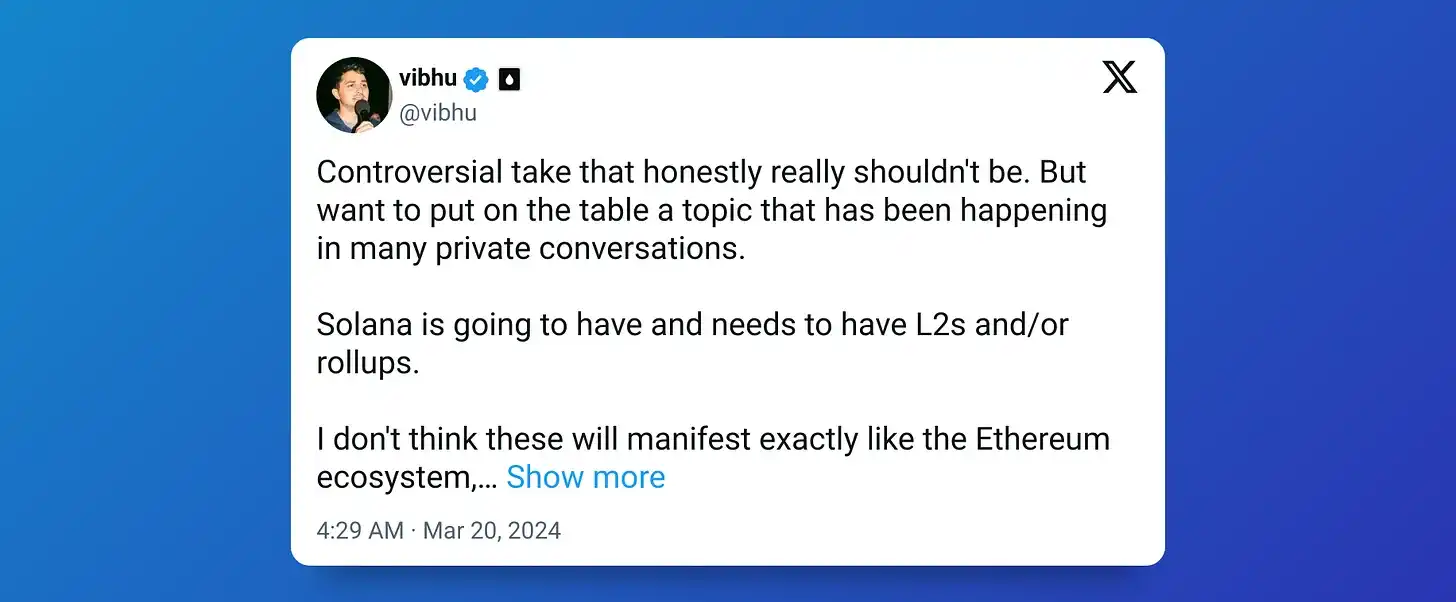
In recent months, Solana has experienced multiple congestion events, from the JUP airdrop to ORE mining and peak meme coin trading. Although some believe that Firedancer can solve these issues, the reality is that the timeline is unclear, and it cannot currently scale beyond 10x. Nevertheless, Solana remains the only major chain that has proven itself in battle and has maintained a single-chain structure.
Should Solana remain a single-chain or become modular?
Will Solana evolve to have sharding Layer 2 and Layer 3 solutions like Ethereum?
What is the current situation of Solana's appchains and Rollup?
To answer these questions and consolidate a summary, this article will explore various possibilities and discuss the pros and cons of each project. This article will not delve into technical details but will discuss various expansion methods from a market-oriented and practical application perspective, providing an overview. All insights, no nonsense, just a wealth of exclusive information.
In short, we will discuss the following issues:
· Solana and network congestion issues
· Making Solana modular
· Solana appchains— with examples
· Solana Layer2 and Rollup— with examples
· Infrastructure supporting Rollup and appchains

Solana's Issues and the Need for Modularity
First, let's discuss the current issues: due to the surge in airdrops and memecoin trading volume, the Solana network has recently been very congested (most of which has been resolved), resulting in high ping times, high transaction failure rates, and increased network fees. Nevertheless, Solana has maintained a transaction processing volume of 1-2 thousand per second, surpassing the total of all EVM chains. This can be considered a good problem faced by blockchain, while also testing Solana's single-chain theory.
The Solana Foundation recently released a blog post, urging projects to take immediate action to improve network performance, including:
· Implementing priority fees: Avoiding transaction delays or losses is crucial.
· Optimizing the use of Compute Units (CUs) to reach optimal states: Using only necessary resources.
· Implementing Quality of Service (QoS) weighted by stake: Allowing applications to prioritize processing user transactions.
However, these measures can only improve transaction completion rates to a certain extent and cannot guarantee a smooth transaction experience. One solution to this problem is the highly anticipated New Transaction Scheduler, planned to be introduced in version 1.18 at the end of April. The new scheduler will coexist with the current scheduler but will not be enabled by default, allowing validators to monitor the performance of the new scheduler and easily switch back to the old scheduler in case of issues. The new scheduler aims to efficiently and affordably fill blocks, addressing the inefficiency issues of the old scheduler.
Read this article to delve into the details of the new scheduler.
Anza, a branch entity of Solana Labs, has been working to address network congestion issues and has identified behavior related to QUIC implementation and the Agave (Solana Labs) validator client handling a large number of requests.
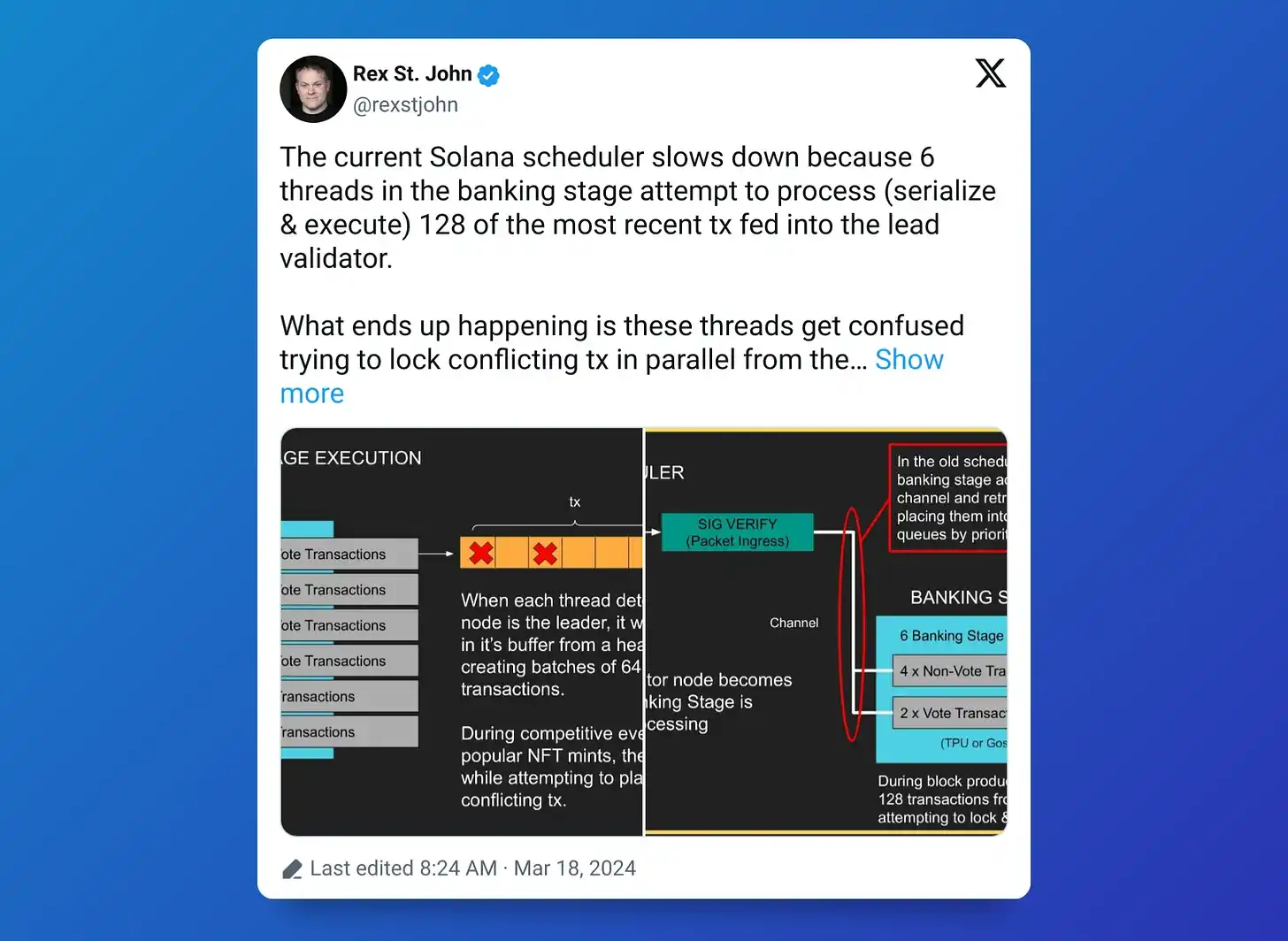
Despite strong advocacy for a "modular roadmap" for Solana, Solana Labs/Anza, the core maintainers of the Solana protocol, remain focused on optimizing throughput and latency issues at the base layer. Potential improvement measures include:
· Improving the fee market and increasing the base fee (currently set at 5000 Lamports or 0.000005 SOL).
· Implementing exponential growth in account write lock fees, gradually increasing fees to curb spam.
· Optimizing CU budget requests through penalty mechanisms.
· Enhancing the overall network architecture.
Even with these vertical scaling, single-chain improvements, we cannot rule out the possibility of Solana adopting horizontal scaling, Rollup. The reality is that Solana can combine both features—it can serve as an excellent base layer for Rollup, with ultra-low block times (approximately 400 milliseconds), significantly enhancing Rollup performance, such as achieving rapid sequencer soft confirmations. Most importantly, Solana has historically implemented changes rapidly, which may make it more efficient as a base layer for Rollup than Ethereum.
Update: Anza has released some patches to help alleviate the ongoing network congestion issues and will further enhance them in v1.18.
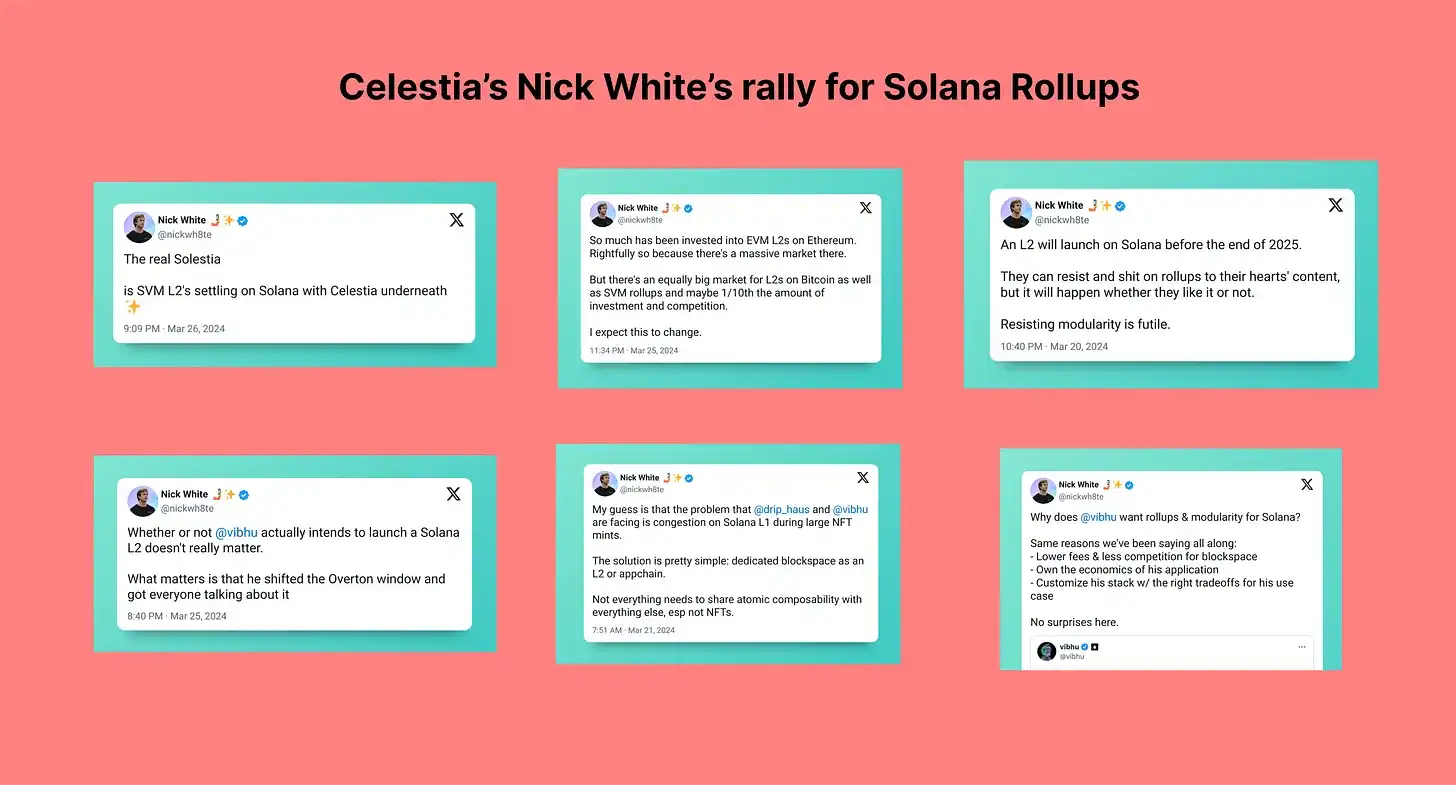
Making Solana Modular
Solana's modular development plan has been initiated. As shown in Anza DevRel's post, Solana validators and SVM (the execution environment for processing transactions and smart contracts/programs) are tightly coupled and maintained by Anza. However, the validator client and SVM runtime will be decoupled in the coming months. This separation will help create "Solana appchains."
For Rollup, optimizing Solana's Data Availability (DA) or blob layer may occur in a later stage.

Source: Anza DevRel
Anza engineer Joe C also revealed plans to modularize SVM, where the transaction processing pipeline will be stripped from the validator and placed into SVM. This will allow developers to run their own implementation of SVM independently of any validator.
The independent SVM will be a collection of fully independent modules. Any SVM implementation can drive these modules through defined interfaces, further reducing barriers for SVM-compatible projects and significantly lowering the overhead required to build custom solutions. Teams can implement only the modules they are interested in while leveraging established implementations, such as modules from Agave or Firedancer.
In summary, Solana will become more plug-and-play, making it easier to implement Solana appchains and Rollup.

Overall, this can lead in two directions: Layer2 (or Rollup) and appchains. We will now discuss each one.
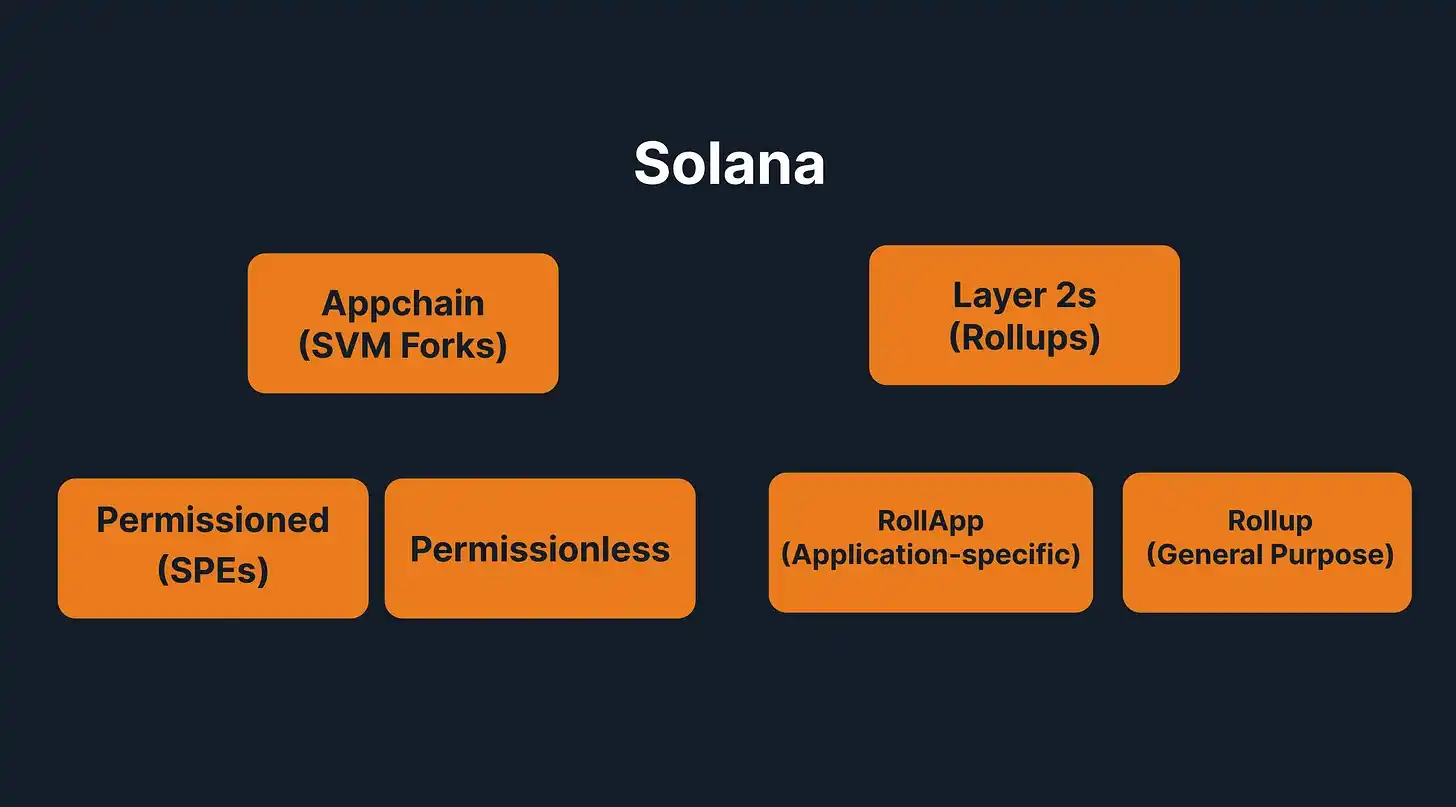
Solana Appchains
Also known as SVM forks, these are essentially Solana chain forks tailored for specific applications. Pyth is the first Solana appchain, but the concept truly gained attention when Maker founder Rune proposed developing a Maker appchain for governance based on the Solana (SVM) codebase. Rune chose SVM for its strong developer community and technical advantages over other VMs, aiming to fork the most performant chain to better meet consumer needs. While not yet implemented, this move sparked widespread discussion about Solana appchains.
In general, they can be divided into two categories:
· Permissionless—Anyone can join the network, similar to the current Solana mainnet.
· Permissioned—Packaged by the Solana Foundation for institutions, "Solana Permissioned Environments (SPEs)" allow entities to build and maintain their own chain instances, supported by SVM.
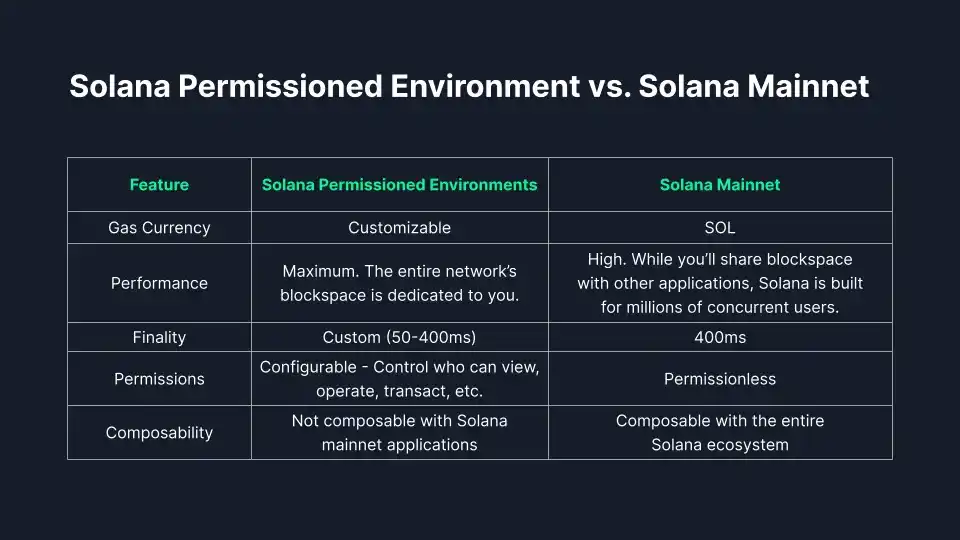
Pyth—OG Solana Appchain:
Pyth once accounted for 10-20% of all transactions on the Solana mainnet. However, it does not require any composability, so they simply forked the Solana codebase. This allowed them to leverage Solana's fast block time of 400 milliseconds for high-frequency price updates. Pythnet is the first network to adopt SVM as its appchain.
Pythnet appchain is an authoritative proof fork of the Solana mainnet, serving as a computational base layer for processing and aggregating data provided by the Pyth data publishing network.
Why the Migration for Pyth?
· It does not require high composability, especially for non-Solana applications, thus unaffected by mainnet congestion.
· It needs a permissioned environment to publish data.
· It reduces infrastructure costs by internalizing fees that previously leaked to the base layer, i.e., Solana.
Cube Exchange is another example, a hybrid CEX deployed as a sovereign SVM appchain with fully offline order book and settlement on its SVM appchain.
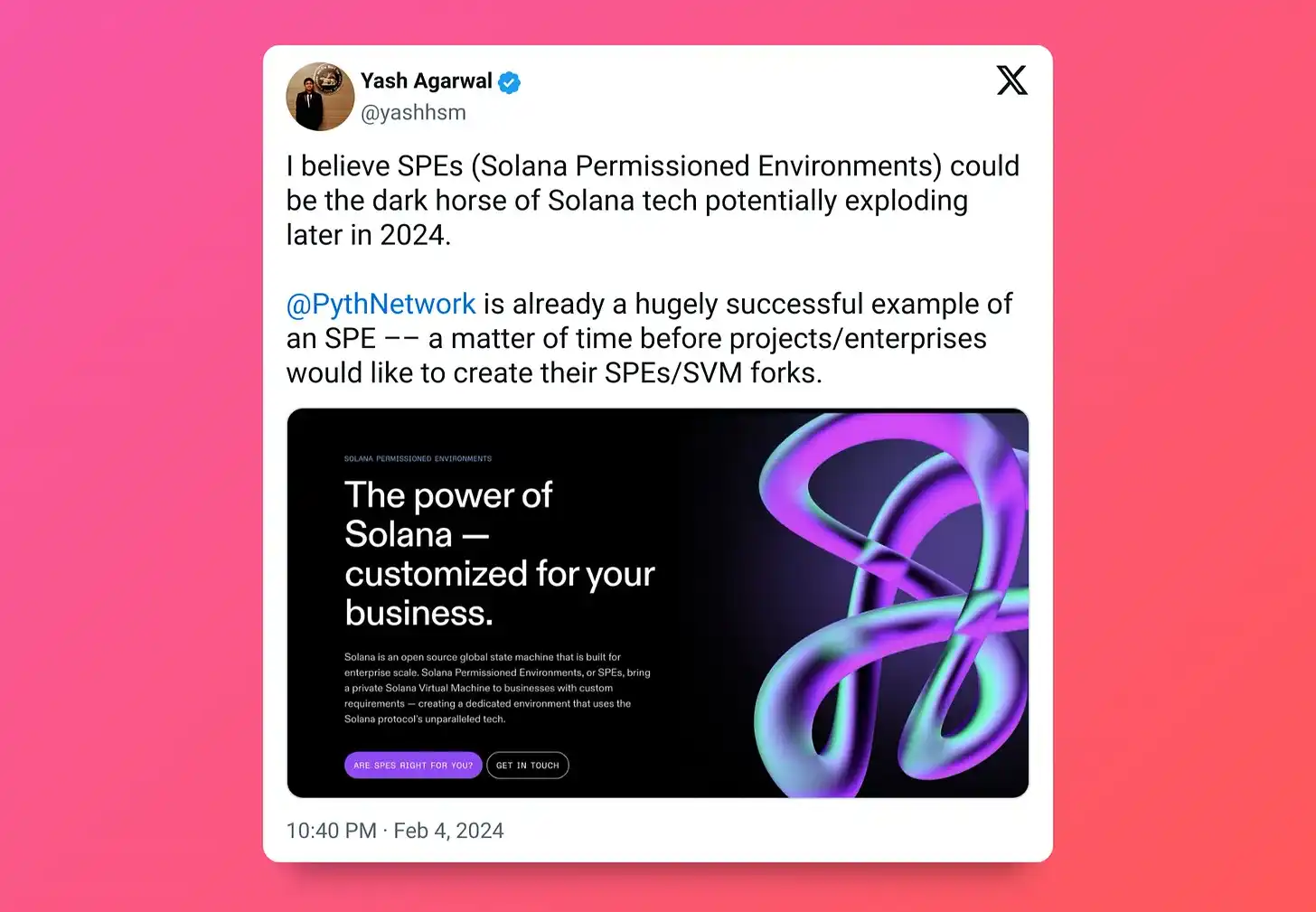
Examples of Solana Appchains
· Perp DEXs: Perp DEXs like Hyperliquid can operate as independent Layer1 networks. Additionally, for trading use cases, customizing the number of transactions per block or implementing conditional logic, such as integrating stop-loss order execution directly into Layer1 to ensure its enforcement as state transitions, or introducing application-specific atomic logic.
· AI and DePIN: These can have curated service provider lists, such as Pyth. For example, Akash operates as a computational marketplace through a Cosmos appchain.
· Governance appchains: The interest of MakerDAO in an SVM appchain validates this, sovereign governance appchains can be very attractive. Cryptogovernance is still evolving, and having dedicated chain forks can be a useful coordination mechanism.
· Future enterprise appchains: Potential applications include funds, such as BlackRock, or payment systems, such as Visa or CBDC.
· Gaming appchains: A casino gaming project running on Solana is considering its appchain.
- Modifying Solana forks: Similar to the optimized EVM (parallelization) provided by Monad or Sei, someone can build a more optimized version of Solana. As the Solana mainnet begins to explore new design architectures, this trend may become more common in the coming years.
Envisioning the Solana Appchain Stack
While building appchains may be relatively simple, ensuring connectivity between all appchains is crucial for interoperability. Drawing inspiration from Avalanche subnets, which connect through local Avalanche Warp Messaging and Cosmos appchains connected via IBC, Solana can also create a local messaging framework to connect these appchains.
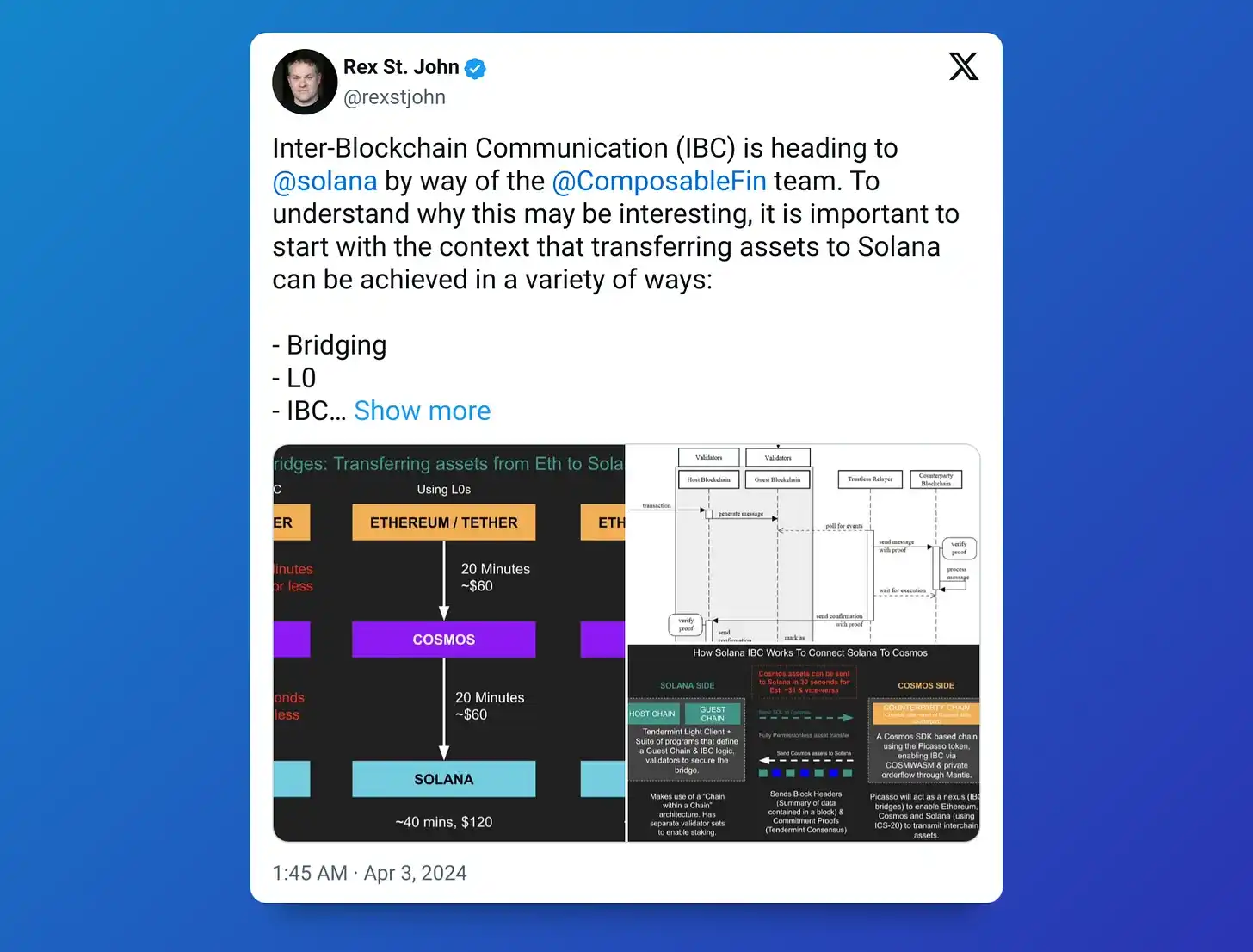
A middleware platform similar to Cosmos-SDK can be built to provide a one-stop service for creating appchains, with built-in support for oracles such as Pyth or Switchboard, remote procedure calls, RPCs like Helius, and messaging connections such as Wormhole.
Polygon's AggLayer offers an innovative solution, allowing developers to link different Layer1 or Layer2 chains into AggLayer, achieving cross-chain aggregation with ZK proofs.
Positive Impact of Appchains on the Solana Ecosystem?
Appchains do not pay fees in SOL or use SOL as the transaction fee token, so they do not directly contribute value to SOL unless re-staked for economic security purposes. However, their benefits to the SVM ecosystem are evident. Similar to the network effect of EVM, more SVM forks and appchains will strengthen the network effect of SVM. Even if Eclipse as an SVM Layer2 extension on Ethereum competes with the Solana mainnet, the same logic applies.
Solana Layer2
Solana Layer2, or Rollup, is a logically independent chain that publishes data to its main chain's Data Availability (DA) layer and reuses the main chain's consensus mechanism. They can also use other DA layers, such as Celestia, but this is no longer a true rollup. The term "RollApp" is often used for rollups specific to applications (which most Solana apps are exploring).
Will Solana's Rollup be like Ethereum's?
Clearly not. For Solana, rollups will be mostly abstracted for end users. Ideologically, Ethereum's rollup is top-down, where the Ethereum Foundation and leaders decide the best way to scale is through rollup, then support various Layer2 solutions after the CryptoKitties incident. In Solana, the demand is bottom-up, coming from app developers with significant user adoption. Therefore, most current roll-up plays are marketing plays, more narrative-driven than user demand-driven. This is a significant difference that may lead to a different future for Solana's rollup compared to Ethereum's.
Is Compression Equivalent to Rollup?
Layer2 scales the base layer blockchain (Layer1) by executing transactions on Layer2, batching transaction data, and compressing it. The compressed data is then sent to Layer1 and used for fraud proofs (optimistic rollup) or validity proofs (zk rollup). This proof process is called "settlement." Similarly, compression unloads transactions from the mainnet, reducing contention for the base layer's state. It is worth noting that Grass Layer2 will utilize state compression for its rollup.
Landscape of Rollup on Solana:
Currently, two projects similar to Rollapps are in operation:
GetCode
This is a payment app with a micro-payment SDK, allowing anyone to make and receive instant payments and use a rollup-like structure for their app. It creates intentions for all transactions and settles on Solana at intervals using a rollup-like sorter.
Using a rollup-like structure enables:
· Flexibility: Intentions can represent various future activities, not just payment transactions. Additionally, if needed, Solana as a chain can be replaced.
· Instant and Privacy: Due to the soft finality of the sorter, payments are instant even during Solana congestion. While transactions are visible on the chain, the exact amount and intentions remain ambiguous, ensuring user privacy.
MagicBlocks' Ephemeral Rollup
MagicBlocks is a web3 game infrastructure that developed Ephemeral Rollup, particularly suitable for gaming. It uses SVM's account structure to split game states into clusters. The state is then temporarily moved to an auxiliary layer or "ephemeral rollup," a configurable dedicated layer. The ephemeral rollup acts as a dedicated SVM runtime or rollup runtime to process transactions at higher throughput.
Using a rollup-like structure enables:
· Customization of dedicated runtime, including gasless transactions, faster block times, and integrated timing mechanisms, such as integrated transaction scheduling systems like Clockwork, running without fees.
· Developers can deploy programs to the base layer, such as Solana, rather than on a separate chain or rollup. The ephemeral rollup does not fragment the existing ecosystem, allowing accelerated target operations without creating isolated environments. This means all existing Solana infrastructure can be leveraged.
This approach helps create a highly scalable system that can launch rollups on demand and automatically scale horizontally to accommodate millions of transactions without the typical trade-offs of traditional Layer2. While MagicBlock focuses on gaming, this approach can also be applied to other areas, such as payments.
Upcoming Solana Rollup:
- Grass: Grass is a DePIN project focused on capturing the data needs of artificial intelligence through validation. The project fetches AI training data through Grass nodes on the network and stores this data on the blockchain by validators, accurately recording the data source and the nodes that performed the fetch, and rewarding them accordingly.
Given that Grass needs to handle up to 1 million network requests per second, this is not feasible for the Solana mainnet. Therefore, the project plans to use zero-knowledge proof technology to validate the dataset and settle in batches on Solana's Layer1.
The Grass team is also considering introducing state compression technology from other clusters and anchoring data on the test version of the Solana mainnet. This innovation will make Grass a foundational platform supporting a wide range of applications that can only be built on it.
*Note that projects building platforms and infrastructure typically have higher market valuations, and Grass is also about to launch its token.
- Zeta: One of the earliest perpetual contract exchanges on Solana, Zeta has a fully on-chain perpetual order book and is currently planning to use Solana's Rollup technology to migrate its trading matching process off-chain.
Perpetual contract exchanges using Rollup technology have significant advantages as it greatly enhances the user trading experience. Users can inquire with those who have traded on platforms like Hyperliquid or Aevo with perpetual contract exchanges on Solana, where users are required to sign every transaction, encounter wallet pop-ups, and wait for approximately 10 to 20 seconds. Additionally, perpetual contract trading does not require synchronous execution and can be highly integrated with other parts of the DeFi ecosystem, especially in terms of trade matching.
Interesting to note, Armani, co-founder of Backpack, also mentioned on Twitter that they are currently focusing on Layer2 solutions.
Sonic is developing a modular SVM chain called Hypergrid, allowing game developers to deploy dedicated chains on the Solana platform. Additionally, there are Ethereum Rollup projects based on SVM technology, such as Eclipse and NitroVM, which use SVM as their execution engine. In the Solana ecosystem, Neon serves as an EVM-compatible Layer 2 solution. Furthermore, innovative projects like Molecule, an SVM Layer 2 for Bitcoin, are still in the early conceptual stage.
Sovereign SDK provides a framework similar to node.js specifically for building Rollups. Users can submit their Rust code, and the platform can convert it into an Optimistic Rollup or ZK Rollup deployable on any blockchain. This Rust code can be custom application logic or an implementation of any virtual machine.
Some Arguments About Rollup
Rollup = Consistency with SOL
"ETH-Aligned" or "ETH Bag Biases" has become a popular network meme.
Why will Layer 2 and Restaking/EigenLayer become the hottest topics?
This is because they increase the "monetization" of ETH, which is used as the core asset everywhere.
The same principle applies to Solana. The Solana community will support any solution that increases their SOL holdings—simple as that. As the Solana ecosystem expands, the once overlooked "monetization" of SOL will become important. Remember, most Rollups are "marketing plays" anyway, and because the market still values infrastructure over applications, they can provide better token value accumulation.
Rollup will feel like an extension of Solana
Apart from the security benefits, inheriting security from the base layer, easy access to Solana users and assets will be a significant advantage. As pointed out by Jon Charbonneau, Ethereum's Rollups like Base, Optimism, and Arbitrum feel more like an extension of Ethereum. Users retain the same wallet and address, the native gas token is a standard version of ETH, ETH dominates in DeFi, all trading pairs are with ETH, social apps price NFTs in ETH and pay creators, for example, friend.tech, and Layer2 deposits are instant, and so on.
Similarly, this will also happen on Solana. Learning from Ethereum, most Solana Rollapps will not make users feel like they are using a separate chain, such as Getcode.
Solana will see more "RollApps" rather than "Rollup"
Solana does not have the scaling issues like Ethereum, where the mainnet becomes difficult to use due to high gas fees; it is highly optimized. However, some applications that require dedicated block space will create their Rollup. While a general Rollup on Solana does not make sense to me, it does make sense economically for projects. For example, Base users generated $2 million in revenue for Coinbase in just one day! The incentives for builders heavily lean towards Layer2. However, as observed, every EVM Rollup seems to be just a regular Rollup, and many projects like Linea, Scroll, or zkSync have become ghost chains where farmers make a few transactions for token airdrops.
Additionally, I feel that general Layer2 on Solana may lead to the same old issues as Ethereum, namely centralized Rollups, congestion, and fragmented liquidity.
Why do some applications want to migrate to Rollapps/Appchains?
Each application will initially launch on the Solana mainnet because hosting more applications on shared infrastructure significantly reduces complexity for developers and users. However, as these applications grow, they may seek:
Value capture. Internalizing value on a shared Solana layer not designed solely for one application is more challenging. MEV capture could be another profitable option for DEX.
Dedicated block space.
Customizability in use cases. For example, in privacy aspects, Getcode uses sequencers to provide private payments for its users, market fee experiments, encrypted memory pools to minimize MEV, and custom order books.
However, not all applications will want to launch their own Rollup, especially those that have not reached a certain escape velocity, such as enough TVL, users, and trading volume. Launching their own chain today involves painful and unnecessary trade-offs, complexity, cost, worse user experience, liquidity fragmentation, etc. Most applications, especially early-stage ones, cannot justify these trade-offs for incremental revenue. Solana remains the core and soul of SVM development, so many new applications may be deployed.
For Application Builders
Whether to use the Solana mainnet, app chains, or Rollups depends entirely on different situations. If there is no strong need for composability with other applications, placing some different components off-chain, whether in app chains or Rollups, is entirely reasonable. Users may not even need to know whether they are using a Rollup or an app chain. Grass, Zeta, and Getcode all abstract the type of Rollup infrastructure they use for their users.
For cases requiring authorization and customization, Token Extension can also meet most needs, such as KYC or transfer logic, while maintaining composability.
Driving Infrastructure for Rollups and App Chains
If the theory of Rollapps/app chains is expanded, existing infrastructure providers will greatly benefit as they enter new markets:
Existing Rollup as a Service (RaaS) providers like Caldera can easily enter the SVM market as demand arises. SVM Ethereum Rollups like Eclipse and NitroVM are also closely watching this opportunity. Additionally, Sovereign Labs provides a Sovereign SDK Solana adapter that can support Rollups on Solana (not yet ready for production). Helius is another company well suited to build infrastructure for Solana Layer2, as Mert has hinted multiple times.
Demand for shared sequencers like Rome Protocol and for light clients like Tinydancer. Shared sequencers could be interesting for Rollups as they can enable activities such as atomic arbitrage, MEV, and seamless bridging, reducing liquidity fragmentation.
Wallets like Phantom, Backpack, and Solflare. Multi-signature and smart contract wallet infrastructure like Squads. Squads has always positioned itself as the "ultimate smart contract wallet infrastructure layer for Solana and SVM."
Re-staking SOL: Modular theory also promotes re-staking, as these Rollups/app chains may need SOL for shared security and consistency with Solana. This will increase the income of early participants like Cambrian, Picaso, and Solayer, validators through Stakenet, and LSTs like Sanctum.
Finally, Can Solana Meet Global Demand?
Of course not. In reality, even considering Moore's Law, even if hardware continues to improve performance, and Solana is optimized for these hardware advances, it is still impractical. I believe that all non-critical transactions, such as DRiP sending NFTs, will eventually move to their own chains, while the most valuable transactions will remain on the main chain, where true composability is crucial, such as spot DEX.
This does not mean that Solana has lost in the battle between monolithic and composability; it will manage better than other chains that rely on composability and low latency. And Sui, Aptos, Sei, Monad, etc., are not better because we do not yet know if they can withstand high real user activity.
Unlike Ethereum, the Solana mainnet does not intend to become a "B2B chain"; it has always been and will always be a consumer chain. Building large-scale distributed systems is extremely challenging, and Solana has the potential to become the shared ledger for the world's most valuable transactions.
Does Solana Need a Soul Mate: Will App Chains and Rollups Be Its Perfect Match?
免责声明:本文章仅代表作者个人观点,不代表本平台的立场和观点。本文章仅供信息分享,不构成对任何人的任何投资建议。用户与作者之间的任何争议,与本平台无关。如网页中刊载的文章或图片涉及侵权,请提供相关的权利证明和身份证明发送邮件到support@aicoin.com,本平台相关工作人员将会进行核查。




